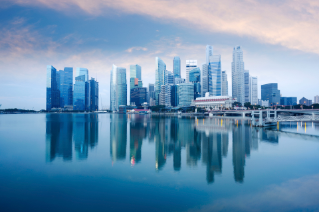EY refers to the global organization, and may refer to one or more, of the member firms of Ernst & Young Global Limited, each of which is a separate legal entity. Ernst & Young Global Limited, a UK company limited by guarantee, does not provide services to clients.
Ernst & Young Solutions LLP (EY) today released its wish list for Singapore Budget 2023.
With a focus on refreshing Singapore’s social compact as the nation advances on its economic growth journey, the government launched the Forward Singapore road map. Accordingly, the proposal measures in EY wish list for Singapore Budget 2023 are aligned with the following six pillars:
- Empower: Economy and Jobs
- Equip: Education and Lifelong Learning
- Care: Health and Social Support
- Build: Home and Living Environment
- Steward: Environment and Fiscal Sustainability
- Unite: Singapore Identity
Ms. Soh Pui Ming, Singapore Head of Tax, Ernst & Young Solutions LLP, says:
“Over the past two years, Singapore has displayed tenacity and cohesiveness as we rode through the disruption brought by the COVID-19 pandemic together. While the pandemic is behind us, Singapore continues to face a highly volatile and uncertain global environment. Hence, we should stay focused as a nation and prime ourselves for any potential challenges and upcoming opportunities.
“Notably, tax and incentives have always been a critical policy tool to shape the nation’s economy and growth. With BEPS 2.0 Pillar 2 just around the corner, it is paramount that we have the right tax measures to continue to attract foreign investments as well as empower Singapore businesses and individuals to grow together.”
Empower: Economy and Jobs
Enhance the mergers and acquisitions (M&A) scheme
The M&A scheme encourages Singapore companies to grow and expand through strategic acquisitions. Qualifying companies that meet the conditions can enjoy up to 25% of the acquisition price (capped at S$10 million per year) as tax deductions over a 5-year period. Since its introduction, the M&A scheme has evolved to be more relevant to the needs of Singapore-based companies conducting M&A. With the looming economic uncertainty, there may be better opportunities for M&A. To enhance its relevance and benefits to Singapore companies, we suggest the following:
- Relax conditions on acquiring subsidiaries under M&A scheme
Currently, an indirect acquisition will only qualify for the M&A scheme if the acquiring subsidiary of the acquiring company meet two qualifying conditions: that it does not carry on a trade or business in Singapore or elsewhere on the date of share acquisition; and it is a 100% owned subsidiary incorporated for the primary purpose of acquiring and holding shares in other companies.
Ms. Sandie Wun, Partner, International Tax and Transaction Services, Ernst & Young Solutions LLP, says:
“We suggest a relaxation to these qualifying conditions currently imposed on the acquiring subsidiary. In particular, for the first condition, the recipient of the income needs to demonstrate business substance in order to enjoy reduction in withholding tax rates as provided under the tax treaties. Hence, relaxing the current criteria to allow the acquiring subsidiary to have some trade or business (such as provision of management or support services) would be helpful.
“For the second condition, we suggest relaxing the requirement for the acquiring subsidiary to be wholly owned throughout the period of the writing down allowances. There are times where businesses use special purpose acquiring subsidiaries to make acquisitions because they want to provide the flexibility to bring in strategic business partners who can help the business. These strategic business partners are usually introduced at the acquiring subsidiary level.”
- Allow M&A allowance to be transferred to other Singapore group companies as part of the group relief system
Currently, M&A allowances cannot be transferred to other Singapore group companies as part of the group relief system.
Mr. Darryl Kinneally, a former EY partner, says:
“As strategic acquisitions are integral to a group’s growth strategy, tax benefits arising from these acquisitions, such as the M&A allowance, should be shared at a Singapore group level. As such, we suggest that M&A allowance on transaction tax costs to be allowed for transfer under group relief scheme. To prevent abuse, this transfer can be limited to group companies that are 100% owned.”
Refine the research and development (R&D) regime
R&D and innovation continue to be a differentiator to propel Singapore’s ambition as a global R&D hub. The existing enhanced R&D deduction of 150% will expire after year of assessment (YA) 2025. More critically, with the impending introduction of BEPS 2.0 Pillar 2, which will significantly reduce any value to the R&D tax incentives, ensuring that Singapore continues to remain competitive in attracting global R&D activities is vital. To encourage companies to continue to set up R&D hubs in Singapore, we suggest extending the enhanced reduction regime, and consider the following refinements:
- Consider the option of a qualified refundable tax credit
Refining the existing R&D tax incentive into a qualified refundable tax credit, which will be compliant with the BEPS 2.0 Pillar 2 rules and accepted globally, could be a way of ensuring that the value of the tax incentive is retained. In addition, reducing taxable income via an R&D tax deduction does not always result in additional funds for R&D activities. Countries such as Australia, Canada, Ireland, New Zealand, the UK and the US are shifting from R&D deductions to R&D credits, as credits are treated as above-the-line for accounting purposes and can be used by companies to offset R&D expenditure internally. The benefit goes back to the company’s R&D team to supplement the R&D budget, whether it is in a tax-paying or tax-loss position. The qualified refundable tax credit will also address this point.
Mr. Johanes Candra, Partner, Business Incentives Advisory, Ernst & Young Solutions LLP, says:
“The existing enhanced tax deduction mechanism reduces the effective tax rate of the company and may not be a helpful tool in light of the territorial effective tax rate computation proposal under BEPS 2.0. Instead, introducing some form of qualified refundable R&D tax credit (compliant with the BEPS 2.0 Pillar 2 rules) could be an alternative in the long run.”
- Allow companies to cash out benefit
Mr. Chai Wai Fook, Partner, Tax Services, Ernst & Young Solutions LLP, says:
“We suggest allowing companies to cash out benefits up to a cap if they are in a tax-loss position. This has been done in Australia, Canada, Ireland, New Zealand, and the UK. The qualified refundable R&D tax credit could also benefit SMEs in terms of allowing a cash-out option.”
- Enhance R&D deductions (beyond 100% base deduction) on overseas R&D activity
Presently, enhanced deduction is not available for R&D activities that are conducted overseas.
Ms. Tan Bin Eng, EY Asean Business Incentives Advisory Leader, says:
“Currently, the enhanced R&D deduction of 150% is available only if the R&D activity is performed in Singapore. We believe that allowing a portion of the R&D activity to be performed overseas can make the existing R&D regime more comprehensive and recognises the collaboration efforts in Singapore and overseas. To prevent abuse, safeguards such as limiting the overseas portion and ensuring a nexus between the overseas activities with Singapore R&D activities can be put in place. Given that the enhanced R&D deduction requires that a taxpayer be the beneficiary of the R&D, allowing a segment of overseas expenditure could further encourage companies to see value in using Singapore as their hub for owning and managing their intellectual property rights.”
Equip: Education and Lifelong Learning
The need for upskilling and capability development has never been more acute, as enterprises look to build a future-ready workforce and adapt jobs accordingly.
Enhanced deduction for staff training
Labour crunch is an imminent concern and the top reason for job vacancies in professional, manager, executive and technician roles is due to a lack in talent with the necessary specialised skills and work experience. This talent gap is more acute among SMEs.
Mr. Samir Bedi, EY Asean Workforce Advisory Leader, says:
“To help businesses, particularly SMEs, invest in the reskilling and upskilling of their workforce, we suggest bringing back the enhanced 300% tax deduction scheme for qualifying staff costs, similar to the Productivity and Innovation Credit scheme but applied in a targeted manner. Specifically, we recommend that this enhanced tax deduction scheme be only available to staff training for SMEs. To accelerate the build-up of workforce with sustainability capabilities, businesses that engage in staff training in sustainability and green economy skills can enjoy the same 300% enhanced deduction claim on related training.”
Workforce transformation
Workforce transformation is a journey and requires a comprehensive approach. To this end, we suggest the Government consider the following enhanced measures.
- Enhance enterprise reskilling support
Mr. Samir Bedi, EY Asean Workforce Advisory Leader, says:
“This can include higher levels of training subsidies and support for unemployed individuals, including stay-at-home mothers who are returning to work. Other initiatives can include higher levels of absentee payroll support to encourage more employers to send employees for upskilling efforts, as well as a top-up of SkillsFuture for Enterprises Credits (SFEC) to provide more resources for enterprise workforce transformation and upskilling efforts. Notably, enterprises were provided with S$10,000 of SFEC in 2020; a top-up of S$50,000 can be provided to encourage more to adopt large-scale and significant workforce improvement efforts.”
Tax relief for personal development
The employment landscape is changing and the skills required to succeed in new industries can be expensive and time-consuming to adopt. The Government currently provides a relief capped at S$5,500 to individuals undertaking courses to support their current or new employment or to gain an academic, professional or vocational qualification.
Mr. Panneer Selvam, EY Asean People Advisory Services - Integrated Mobile Talent Leader, says:
“Individuals have to adopt a digital mindset and upskill to be relevant and future-ready. As costs increase, it may be timely to increase the relief cap to further support individuals who are investing in their future by undertaking courses, particularly in sustainability and green economy as well as digital skills. The cap can be differentiated by sector to give an added incentive for individuals to train in industries of focus.”
Care: Health and Social Support
Extend reliefs for working mothers to their spouses
Reliefs that are traditionally provided only to working mothers, such as the Grandparent Caregiver Relief (GCR) and Working Mothers Child relief (WMCR), can be extended to their spouses.
Ms. Kerrie Chang, Partner, People Advisory Services - Mobility Tax, Ernst & Young Solutions LLP, says:
“Child-raising is a joint responsibility of both parents. These reliefs should be shared with the husband, perhaps with the condition that the wife is working. Extending these reliefs to be shared with the husband recognises the teamwork required between the husband and the wife in providing for a family.”
Extend Foreign Maid Levy (FML) relief to single people and married men
Currently, FML relief is given to encourage married women to stay in or return to the workforce. Married women and divorcees or widows with school-going children can claim this relief. Singles and married men are not eligible to claim.
Mr. Panneer Selvam, EY Asean People Advisory Services - Integrated Mobile Talent Leader, says:
“Whether single or married, men or women, working adults who engage domestic helpers to provide care and support to their ageing parents should also be allowed to claim FWL relief.”
Build: Home and Living Environment
Enhance section 14N deduction
The COVID-19 pandemic has changed workplace settings. Hybrid work arrangement has become a permanent feature for many businesses, and workplaces are seen more as a place for collaboration and networking. Companies will need to renovate and redesign their spaces to allow flexibility and foster collaboration.
Ms. Toh Shu Hui, Partner, Tax Services, Ernst & Young Solutions LLP, says:
“To facilitate workplace transformation, we suggest raising the cap from the current S$300,000 to S$600,000; and shortening the relevant period from 3 years to 2 years. We also suggest that the enhancements to the cap and relevant period be made a temporarily one, for YA 2023 and YA 2024 only.”
Steward: Environment and Fiscal Sustainability
Include carbon credits as designated investments for funds tax incentive schemes
The current list of designated investments (DI) for the 13D/O/U schemes includes only emission derivatives.
According to the MAS, the global demand for voluntary carbon credits is expected to grow 15-fold over the next 10 years to 2 billion tonnes in 2030. With effect from 2025, Singapore will allow the use of high-quality carbon credits to offset carbon taxes.
Mr. Desmond Teo, EY Asean Private Tax Leader, says:
“We observed that investors are taking a keen interest in the carbon market to achieve sustainability objectives for their portfolios. To facilitate the trading liquidity of carbon credits, we suggest that carbon credits be included in the list of DI.”
Encourage early adoption of electric vehicles (EVs)
The use of private cars has been discouraged in Singapore, due to the negative externalities that they create, including road congestion and environmental pollution.
Tax deduction was restricted on expenses incurred on private cars registered before 1 April 1998. Subsequent to the vehicle rationalisation exercise in 1998, any expense incurred on private cars is disallowed for tax deduction. Input tax paid on private cars are also not claimable for GST purpose.
Mr. Yeo Kai Eng, EY Asean Indirect Tax Leader, says:
“The recent Budgets have introduced various incentives to encourage the early adoption of EVs. To further encourage adoption, for GST, we suggest that input tax be claimable on the GST incurred for expenses incurred in relation to EVs. Likewise, expenses incurred on EVs by businesses should be fully tax deductible and capital allowances claimable on the purchase of EVs.”
Unite: Singapore Identity
Make the 250% tax deduction for qualifying donations a permanent feature
Donors qualify for a 250% tax deduction on approved donations made to Institutions of a Public Character (IPC) and other qualifying recipients from 1 January 2016 to 31 December 2021. This 250% deduction for donations is extended to 31 December 2023 in Budget 2021.
Mr. Chia Seng Chye, Partner, Tax Services, Ernst & Young Solutions LLP, says:
“To encourage the spirit of philanthropy for corporates and in line with the call to make Singapore a more compassionate society, we suggest that the 250% tax deduction for qualifying donations beyond 31 December 2023 be made a permanent feature.”
Tax relief for volunteering time
Volunteering of time has not been recognised the same way outside of the corporate Business & IPC Partnership Scheme (BIPS).
According to the National Volunteer and Philanthropy Centre's Individual Giving Study 2021, Singapore’s volunteerism rate fell from 29% in 2018 to 22% in 2021. The number of hours volunteered also fell from a median 24 hours in 2018 to 12 hours in 2021.
Mr. Panneer Selvam, EY Asean People Advisory Services - Integrated Mobile Talent Leader, says:
“To build a caring and cohesive society, individuals giving their time to serve the community and the underprivileged should be acknowledged. To recognise this personal commitment, we recommend a tax relief of S$3,000 for individuals who volunteer with an IPC in their personal capacities for 30 hours or more in a calendar year.”
-ends-
About EY
EY exists to build a better working world, helping to create long-term value for clients, people and society and build trust in the capital markets.
Enabled by data and technology, diverse EY teams in over 150 countries provide trust through assurance and help clients grow, transform and operate.
Working across assurance, consulting, law, strategy, tax and transactions, EY teams ask better questions to find new answers for the complex issues facing our world today.
EY refers to the global organization, and may refer to one or more, of the member firms of Ernst & Young Global Limited, each of which is a separate legal entity. Ernst & Young Global Limited, a UK company limited by guarantee, does not provide services to clients. Information about how EY collects and uses personal data and a description of the rights individuals have under data protection legislation are available via ey.com/privacy. EY member firms do not practice law where prohibited by local laws. For more information about our organization, please visit ey.com.
This news release has been issued by Ernst & Young Solutions LLP, a member of the global EY organization.
Related news
Businesses fear global tax reform will lead to double taxation
Global tax reform, ineffective use of technology and economic uncertainty are putting significant strain on businesses’ transfer pricing (TP) capabilities.
beps 2 0 readiness is top of mind for cfos and tax leaders survey finds
The rapidly changing regulatory landscape is creating a significant challenge for tax and finance departments, according to the latest EY Tax and Finance Operations Survey (TFO)
EY reactions to Singapore Budget 2023
EY today released its reactions to the Singapore Budget 2023, themed “Moving forward in a new era”.
Wish list for Singapore Budget 2023
Ernst & Young Solutions LLP (EY) today released its wish list for Singapore Budget 2023.
EY startup incubator program announces its fifth cohort of startups
Singapore, 4 July 2022. The EY organization today announced the winning startup participants accepted into EY Foundry Cohort 5.
Janet Truncale selected as next EY Global Chair and CEO; effective July 1, 2024
LONDON, 15 November 2023. EY today announces that Janet Truncale has been elected the next EY Global Chair and CEO, effective from 1 July 2024.







